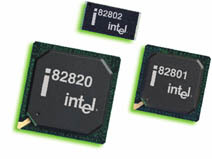Showdown at 133 MHz FSB - Part 2, The Real McCoy
Intel 820 Chipset
I've written so much about i820 and 'Caminogate' that I will try to keep myself short this time. Of course i820 is using Intel's new 'hub architecture', it supports AGP4x and ATA66. The i820-chipset was designed to use RDRAM in the first place and later Intel added a peculiar kind of SDRAM-support. i820 sports one Rambus-channel, which means that it offers one 16 bit wide RDRAM-interface. Thus the highest memory bandwidth would be 1.6 GB/s in case of PC800 RDRAM or less in case that PC700 or only PC600 are used.
Alternatively i820 can be equipped with a 'MTH'-chip that offers PC100 SDRAM-support to save costs. Unfortunately the MTH re-translates the Rambus-protocol back to SDRAM-protocol, so that a system with this configuration can neither take advantage of the high data bandwidth of RDRAM (because it's not used), nor of the lower latency of SDRAM, because the SDRAM doesn't talk to the CPU directly, but 'through' the Rambus-protocol, which is already loaded with high latency. The only interesting thing about the MTH is the fact that it always runs at the 400 MHz that PC800 RDRAM would run at. Therefore the SDRAM 'behind' the MTH receives the commands at a faster rate than PC700 or PC600 RDRAM would. You will see why this is an important consideration when you look at the benchmark results below.
Get Tom's Hardware's best news and in-depth reviews, straight to your inbox.

